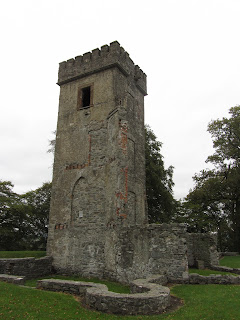The Round Hill-Fort of Cu Chulainn:
This ancient earthen fort, dating back about 2,000 years, is the alleged fort of Cu Chulainn, a famous warrior from Celtic mythology who is known as the Defender of Ulster. It is located in the far northern portion of County Louth, in the Cooley Mountains of the borderlands, and archeologically, is believed to be the ruins of a fortified corral, for guarding the local Celtic tribe's cattle against raids from neighboring war bands. This ties into the legend of Cu Chulainn, whose most famous act in Celtic mythology is when he defended the Brown Bull of Ulster against the invading army of Queen Meadb of Connacht in the Celtic Epic "The Cattle Raid of Cooley."
The Battle of Moyry Pass- The Gap of the North:
From 1594-1603, the Gaelic Irish of Ulster led by Hugh O'Neill, the Earl of Tyrone, fought what came to be known as the Nine Years War against the English rule in Ireland. In 1600, an English Army under Lord Mountjoy marched north from Dublin to crush this rebellion in the North, but they were held up at the Gap of the North, in the Cooley Mountains along the border of County Armagh and County Louth, where Hugh O'Neill had set up a defensive position in Moyry Pass. Initially repulsed by O'Neill's forces, the English under Mountjoy continued to assault the Gap over about a two week period. After two weeks of continuous attack, the Ulster Irish were forced to withdraw from the pass, thus letting in the invading English Army, which set upon a policy of scorched earth tactics, to bring the rebellion to its knees, burning farms and fields as they went. Three years later, O'Neill and his forces were finally forced to surrender, and control of Northern Ireland has been yielded to the British ever since. Mounjoy Castle, still standing in the Gap of th North today, is a reminder of the initial occupation following the battle, and a lasting legacy of English rule in Ulster.






No comments:
Post a Comment